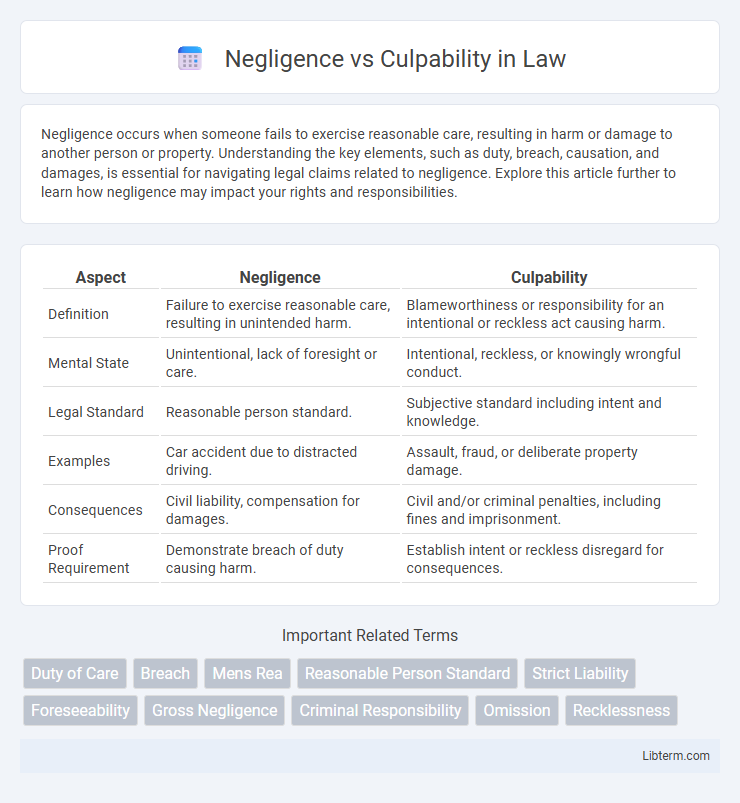Negligence occurs when someone fails to exercise reasonable care, resulting in harm or damage to another person or property. Understanding the key elements, such as duty, breach, causation, and damages, is essential for navigating legal claims related to negligence. Explore this article further to learn how negligence may impact your rights and responsibilities.
Table of Comparison
| Aspect | Negligence | Culpability |
|---|---|---|
| Definition | Failure to exercise reasonable care, resulting in unintended harm. | Blameworthiness or responsibility for an intentional or reckless act causing harm. |
| Mental State | Unintentional, lack of foresight or care. | Intentional, reckless, or knowingly wrongful conduct. |
| Legal Standard | Reasonable person standard. | Subjective standard including intent and knowledge. |
| Examples | Car accident due to distracted driving. | Assault, fraud, or deliberate property damage. |
| Consequences | Civil liability, compensation for damages. | Civil and/or criminal penalties, including fines and imprisonment. |
| Proof Requirement | Demonstrate breach of duty causing harm. | Establish intent or reckless disregard for consequences. |
Understanding Negligence: Key Concepts
Negligence involves a failure to exercise the level of care that a reasonably prudent person would under similar circumstances, resulting in unintentional harm or damage. Key concepts include duty of care, breach of that duty, causation, and resulting damages. Understanding these elements is crucial to distinguishing negligence from culpability, which implies intentional wrongdoing or criminal liability.
Defining Culpability in Law
Culpability in law refers to the degree of blameworthiness assigned to a person for their actions or omissions that cause harm or violate legal duties. It involves assessing intentionality, recklessness, negligence, or strict liability to determine moral and legal responsibility. Unlike negligence, which focuses on a failure to exercise reasonable care, culpability encompasses a broader spectrum of mental states that establish guilt or fault in criminal and civil law.
Core Differences Between Negligence and Culpability
Negligence involves a failure to exercise reasonable care, resulting in unintended harm, while culpability denotes a state of blameworthiness based on intentional or reckless conduct. The core difference lies in the mental state: negligence is characterized by carelessness or omission, whereas culpability requires a conscious decision or awareness of wrongful actions. Legal consequences vary, with negligence often leading to civil liability and culpability potentially resulting in criminal charges.
Types of Negligence in Legal Contexts
Types of negligence in legal contexts include gross negligence, which involves a severe lack of care demonstrating reckless disregard for others' safety, and contributory negligence, where the injured party's own carelessness partly causes the harm. Comparative negligence allows courts to allocate fault percentages and adjust damages accordingly, while criminal negligence denotes conduct so careless it results in criminal liability. Understanding these distinctions is essential for properly assessing liability and damages in tort cases.
Levels of Culpability Explained
Levels of culpability are categorized to determine the degree of blameworthiness in negligent acts, ranging from negligence, recklessness, knowledge, to intentional wrongdoing. Negligence involves a failure to exercise reasonable care, while recklessness indicates conscious disregard of substantial risks. Culpability increases with knowledge of harm and is highest when actions are intentional, reflecting a deliberate intent to cause damage or injury.
Legal Standards: Proving Negligence vs Proving Culpability
Proving negligence requires demonstrating a duty of care breached resulting in harm, emphasizing the failure to act as a reasonable person would under similar circumstances. Proving culpability involves establishing intentional wrongdoing or criminal intent, requiring evidence of mens rea, or a guilty mind, alongside the actus reus, the wrongful act. Legal standards for negligence rest on objective criteria of carelessness, while culpability demands subjective proof of intent or recklessness.
Real-world Examples of Negligence and Culpability
Negligence occurs when a person fails to exercise reasonable care, such as a driver running a red light and causing an accident, while culpability implies a higher degree of blameworthiness, like intentionally causing harm in a physical assault. In workplace incidents, negligence might involve ignoring safety protocols that lead to injury, whereas culpability could be demonstrated by deliberately sabotaging equipment to endanger colleagues. Courts distinguish these concepts to assign appropriate legal consequences based on the level of intent or carelessness demonstrated in the act.
Consequences and Penalties for Negligence and Culpability
Negligence typically results in civil penalties such as fines, compensation for damages, or corrective actions, reflecting a failure to exercise reasonable care without intent to harm. Culpability, involving intentional or reckless conduct, often leads to harsher consequences including criminal charges, imprisonment, and higher fines due to the willful nature of the offense. Legal systems distinguish between these to ensure penalties are proportional to the degree of fault and harm caused.
Preventing Negligence and Culpable Acts
Preventing negligence and culpable acts requires implementing strict safety protocols, comprehensive employee training, and regular risk assessments to identify and mitigate potential hazards. Establishing a culture of accountability and clear communication channels ensures individuals understand their legal and ethical responsibilities, reducing instances of carelessness and intentional misconduct. Utilizing technology such as monitoring systems and automated compliance checks strengthens oversight and helps detect early signs of negligent or culpable behavior.
Frequently Asked Questions: Negligence vs Culpability
Negligence involves a failure to exercise reasonable care, leading to unintended harm, while culpability refers to the degree of blameworthiness or intent behind a wrongful act. Frequently asked questions about negligence vs culpability often address how courts differentiate between careless actions and deliberate wrongdoing in determining liability and sentencing. Understanding the distinctions helps clarify legal responsibilities, as negligence requires proving lack of reasonable care, whereas culpability involves proof of intentional or reckless conduct.
Negligence Infographic

 libterm.com
libterm.com